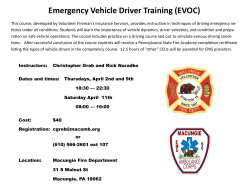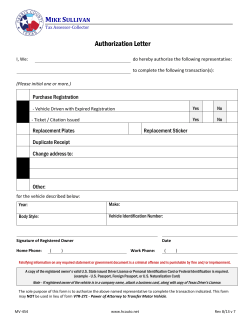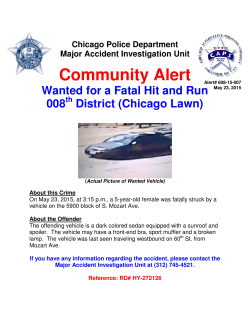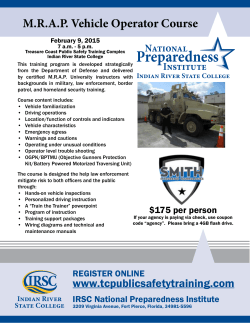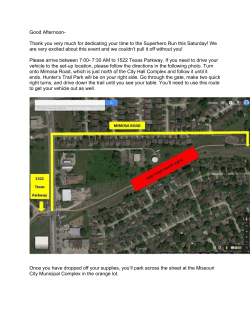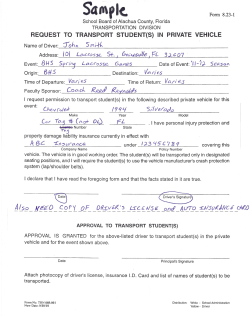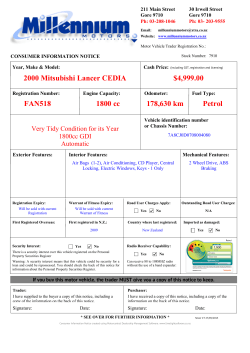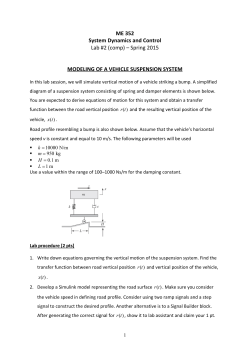
DENVER POLICE DEPARTMENT
DENVER POLICE DEPARTMENT OMS 105.05 – Discharge of Firearms 105.05 Discharge of Firearms (revised 06-2015) (1) Officers shall not discharge any firearm in the performance of their duties except as authorized by law and the rules, regulations and procedures of the Denver Police Department. (2) All members of the Denver Police Department shall safely handle firearms while performing on-duty assignments and at all times while carrying/handling firearms while off-duty. (3) When all reasonable alternatives appear impractical, a law enforcement officer may resort to the lawful use of firearms under the following conditions when he/she reasonably believes that it is necessary. When feasible, it is necessary, to give some warning before engaging in the use of deadly force. If possible, identify yourself as a police officer, give the command you want followed, and state your intention to shoot. a. To defend him/herself, or a third person from what he/she reasonably believes to be the use or imminent use of deadly physical force (C.R.S. §18-1-707); or b. To affect an arrest, or to prevent the escape from custody of a person whom he/she reasonably believes: 1. Has committed or attempted to commit a felony involving the use or threatened use of a deadly weapon; or 2. Is attempting to escape by the use of a deadly weapon; or 3. Otherwise indicates, except through a motor vehicle violation, that he is likely to endanger human life or to inflict serious bodily injury to another unless apprehended without delay. (C.R.S. §18-1-707). 4. The following definitions shall apply to all of OMS 105.04(3) a. and b: a. REASONABLE BELIEF: When facts or circumstances the officer reasonably believes, knows, or should know, are such as to cause an ordinary and prudent police officer to act or think in a similar way under similar circumstances. b. DEADLY PHYSICAL FORCE: That force, the intended, natural, and probable consequence of which is to produce death and which does, in fact, produce death. c. SERIOUS BODILY INJURY: Bodily injury which, either at the time of the actual injury or at a later time, involves a substantial risk of death, a substantial risk of serious permanent disfigurement, a substantial risk or protracted loss or impairment of the function of any part or organ of the body, or breaks, fractures (to include breaks or fractures of hard tissue such as bone, teeth, or cartilage) or burns of the second or third degree. c. A law enforcement officer may also engage in the lawful use of firearms under the following conditions: 1. To kill a dangerous animal or one that humane treatment requires its removal from further suffering and alternative methods of disposition are impractical. 2. To participate in authorized training at a target range. 3. To participate in any legitimate sporting activity. (4) Officers will not discharge firearms under the following conditions: a. At another person unless the circumstances are such that the officer would be justified under the law if the shot killed the person. b. Where there is likelihood of serious injury to persons other than the person to be apprehended. c. As a warning or attention shots. APPROVED – June 8, 2015 Page 1 of 2 DENVER POLICE DEPARTMENT OMS 105.05 – Discharge of Firearms (5) (6) d. Solely to protect property. e. At a moving vehicle, see below Moving vehicles a. Firearms shall not be discharged at a moving or fleeing vehicle unless deadly force is being used against the police officer or another person present by means other than the moving vehicle. b. Officers shall exercise good judgment and not move into or remain in the path of a moving vehicle. Moving into or remaining in the path of a moving vehicle, whether deliberate or inadvertent, shall not be justification for discharging a firearm at the vehicle or any occupant. An officer in the path of a vehicle shall attempt to move to a position of safety rather than discharging a firearm at the vehicle or any of the occupants. c. Firing at moving vehicles is prohibited for the following reasons: 1. Firing at a moving vehicle may have very little impact on stopping the vehicle. 2. Disabling the driver may result in an uncontrolled vehicle, and the likelihood of injury to occupants of the vehicle (who may not be involved in the crime) may be increased when the vehicle is either out of control or shots are fired into the passenger compartment. d. It is understood that the policy in regards to discharging a firearm at a moving vehicle, like all written policies, may not cover every situation. Any deviations shall be examined rigorously on a case-by-case basis. e. Officers are discouraged from immediately approaching a stopped vehicle at the conclusion of a pursuit or other high-risk stop. Where reasonably possible, officers shall use the felony stop tactic. f. Firing from a moving vehicle: Accuracy may be severely impacted when firing from a moving vehicle, and firing from a moving vehicle may increase the risk of harm to officers or other citizens. Officers should not fire from a moving vehicle except in self defense or defense of another from what the officer reasonably believes to be the use or imminent use of deadly physical force. Above all, the safety of the public and the officer must be the overriding concern when the use of force is considered. APPROVED – June 8, 2015 Page 2 of 2
© Copyright 2025
